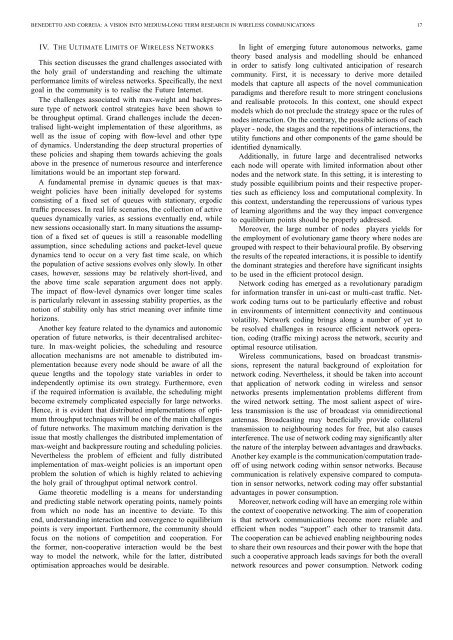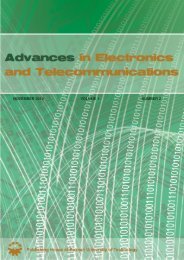channel - Advances in Electronics and Telecommunications
channel - Advances in Electronics and Telecommunications
channel - Advances in Electronics and Telecommunications
You also want an ePaper? Increase the reach of your titles
YUMPU automatically turns print PDFs into web optimized ePapers that Google loves.
BENEDETTO AND CORREIA: A VISION INTO MEDIUM-LONG TERM RESEARCH IN WIRELESS COMMUNICATIONS 17<br />
IV. THE ULTIMATE LIMITS OF WIRELESS NETWORKS<br />
This section discusses the gr<strong>and</strong> challenges associated with<br />
the holy grail of underst<strong>and</strong><strong>in</strong>g <strong>and</strong> reach<strong>in</strong>g the ultimate<br />
performance limits of wireless networks. Specifically, the next<br />
goal <strong>in</strong> the community is to realise the Future Internet.<br />
The challenges associated with max-weight <strong>and</strong> backpressure<br />
type of network control strategies have been shown to<br />
be throughput optimal. Gr<strong>and</strong> challenges <strong>in</strong>clude the decentralised<br />
light-weight implementation of these algorithms, as<br />
well as the issue of cop<strong>in</strong>g with flow-level <strong>and</strong> other type<br />
of dynamics. Underst<strong>and</strong><strong>in</strong>g the deep structural properties of<br />
these policies <strong>and</strong> shap<strong>in</strong>g them towards achiev<strong>in</strong>g the goals<br />
above <strong>in</strong> the presence of numerous resource <strong>and</strong> <strong>in</strong>terference<br />
limitations would be an important step forward.<br />
A fundamental premise <strong>in</strong> dynamic queues is that maxweight<br />
policies have been <strong>in</strong>itially developed for systems<br />
consist<strong>in</strong>g of a fixed set of queues with stationary, ergodic<br />
traffic processes. In real life scenarios, the collection of active<br />
queues dynamically varies, as sessions eventually end, while<br />
new sessions occasionally start. In many situations the assumption<br />
of a fixed set of queues is still a reasonable modell<strong>in</strong>g<br />
assumption, s<strong>in</strong>ce schedul<strong>in</strong>g actions <strong>and</strong> packet-level queue<br />
dynamics tend to occur on a very fast time scale, on which<br />
the population of active sessions evolves only slowly. In other<br />
cases, however, sessions may be relatively short-lived, <strong>and</strong><br />
the above time scale separation argument does not apply.<br />
The impact of flow-level dynamics over longer time scales<br />
is particularly relevant <strong>in</strong> assess<strong>in</strong>g stability properties, as the<br />
notion of stability only has strict mean<strong>in</strong>g over <strong>in</strong>f<strong>in</strong>ite time<br />
horizons.<br />
Another key feature related to the dynamics <strong>and</strong> autonomic<br />
operation of future networks, is their decentralised architecture.<br />
In max-weight policies, the schedul<strong>in</strong>g <strong>and</strong> resource<br />
allocation mechanisms are not amenable to distributed implementation<br />
because every node should be aware of all the<br />
queue lengths <strong>and</strong> the topology state variables <strong>in</strong> order to<br />
<strong>in</strong>dependently optimise its own strategy. Furthermore, even<br />
if the required <strong>in</strong>formation is available, the schedul<strong>in</strong>g might<br />
become extremely complicated especially for large networks.<br />
Hence, it is evident that distributed implementations of optimum<br />
throughput techniques will be one of the ma<strong>in</strong> challenges<br />
of future networks. The maximum match<strong>in</strong>g derivation is the<br />
issue that mostly challenges the distributed implementation of<br />
max-weight <strong>and</strong> backpressure rout<strong>in</strong>g <strong>and</strong> schedul<strong>in</strong>g policies.<br />
Nevertheless the problem of efficient <strong>and</strong> fully distributed<br />
implementation of max-weight policies is an important open<br />
problem the solution of which is highly related to achiev<strong>in</strong>g<br />
the holy grail of throughput optimal network control.<br />
Game theoretic modell<strong>in</strong>g is a means for underst<strong>and</strong><strong>in</strong>g<br />
<strong>and</strong> predict<strong>in</strong>g stable network operat<strong>in</strong>g po<strong>in</strong>ts, namely po<strong>in</strong>ts<br />
from which no node has an <strong>in</strong>centive to deviate. To this<br />
end, underst<strong>and</strong><strong>in</strong>g <strong>in</strong>teraction <strong>and</strong> convergence to equilibrium<br />
po<strong>in</strong>ts is very important. Furthermore, the community should<br />
focus on the notions of competition <strong>and</strong> cooperation. For<br />
the former, non-cooperative <strong>in</strong>teraction would be the best<br />
way to model the network, while for the latter, distributed<br />
optimisation approaches would be desirable.<br />
In light of emerg<strong>in</strong>g future autonomous networks, game<br />
theory based analysis <strong>and</strong> modell<strong>in</strong>g should be enhanced<br />
<strong>in</strong> order to satisfy long cultivated anticipation of research<br />
community. First, it is necessary to derive more detailed<br />
models that capture all aspects of the novel communication<br />
paradigms <strong>and</strong> therefore result to more str<strong>in</strong>gent conclusions<br />
<strong>and</strong> realisable protocols. In this context, one should expect<br />
models which do not preclude the strategy space or the rules of<br />
nodes <strong>in</strong>teraction. On the contrary, the possible actions of each<br />
player - node, the stages <strong>and</strong> the repetitions of <strong>in</strong>teractions, the<br />
utility functions <strong>and</strong> other components of the game should be<br />
identified dynamically.<br />
Additionally, <strong>in</strong> future large <strong>and</strong> decentralised networks<br />
each node will operate with limited <strong>in</strong>formation about other<br />
nodes <strong>and</strong> the network state. In this sett<strong>in</strong>g, it is <strong>in</strong>terest<strong>in</strong>g to<br />
study possible equilibrium po<strong>in</strong>ts <strong>and</strong> their respective properties<br />
such as efficiency loss <strong>and</strong> computational complexity. In<br />
this context, underst<strong>and</strong><strong>in</strong>g the repercussions of various types<br />
of learn<strong>in</strong>g algorithms <strong>and</strong> the way they impact convergence<br />
to equilibrium po<strong>in</strong>ts should be properly addressed.<br />
Moreover, the large number of nodes players yields for<br />
the employment of evolutionary game theory where nodes are<br />
grouped with respect to their behavioural profile. By observ<strong>in</strong>g<br />
the results of the repeated <strong>in</strong>teractions, it is possible to identify<br />
the dom<strong>in</strong>ant strategies <strong>and</strong> therefore have significant <strong>in</strong>sights<br />
to be used <strong>in</strong> the efficient protocol design.<br />
Network cod<strong>in</strong>g has emerged as a revolutionary paradigm<br />
for <strong>in</strong>formation transfer <strong>in</strong> uni-cast or multi-cast traffic. Network<br />
cod<strong>in</strong>g turns out to be particularly effective <strong>and</strong> robust<br />
<strong>in</strong> environments of <strong>in</strong>termittent connectivity <strong>and</strong> cont<strong>in</strong>uous<br />
volatility. Network cod<strong>in</strong>g br<strong>in</strong>gs along a number of yet to<br />
be resolved challenges <strong>in</strong> resource efficient network operation,<br />
cod<strong>in</strong>g (traffic mix<strong>in</strong>g) across the network, security <strong>and</strong><br />
optimal resource utilisation.<br />
Wireless communications, based on broadcast transmissions,<br />
represent the natural background of exploitation for<br />
network cod<strong>in</strong>g. Nevertheless, it should be taken <strong>in</strong>to account<br />
that application of network cod<strong>in</strong>g <strong>in</strong> wireless <strong>and</strong> sensor<br />
networks presents implementation problems different from<br />
the wired network sett<strong>in</strong>g. The most salient aspect of wireless<br />
transmission is the use of broadcast via omnidirectional<br />
antennas. Broadcast<strong>in</strong>g may beneficially provide collateral<br />
transmission to neighbour<strong>in</strong>g nodes for free, but also causes<br />
<strong>in</strong>terference. The use of network cod<strong>in</strong>g may significantly alter<br />
the nature of the <strong>in</strong>terplay between advantages <strong>and</strong> drawbacks.<br />
Another key example is the communication/computation tradeoff<br />
of us<strong>in</strong>g network cod<strong>in</strong>g with<strong>in</strong> sensor networks. Because<br />
communication is relatively expensive compared to computation<br />
<strong>in</strong> sensor networks, network cod<strong>in</strong>g may offer substantial<br />
advantages <strong>in</strong> power consumption.<br />
Moreover, network cod<strong>in</strong>g will have an emerg<strong>in</strong>g role with<strong>in</strong><br />
the context of cooperative network<strong>in</strong>g. The aim of cooperation<br />
is that network communications become more reliable <strong>and</strong><br />
efficient when nodes “support” each other to transmit data.<br />
The cooperation can be achieved enabl<strong>in</strong>g neighbour<strong>in</strong>g nodes<br />
to share their own resources <strong>and</strong> their power with the hope that<br />
such a cooperative approach leads sav<strong>in</strong>gs for both the overall<br />
network resources <strong>and</strong> power consumption. Network cod<strong>in</strong>g







